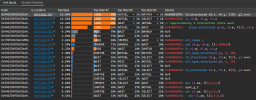Silent_Buddha
Legend
But you can say that still image comparisons (I have issues with this, so it isn't something I agree with) in that type of essentially academic comparison is used as a part of the marketing for games and therefore is relevant in terms of how it's received.
While at the same time if the performance gains are low (say in 5% range mentioned earlier) than they too you would argue as so low you wouldn't notice them outside of an academic comparison either. And as of now that 5% performance gain isn't really something marketable.
Keep in mind that it may be 5% over X time or Y frames, but it might be 20%+ for a single frame or a few frames. IE - enough to prevent there being a serious hiccup or judder that might have happened if you didn't have VRS.
Average framerate is a very imprecise method with which to judge how effective any given technique is, especially if it's use is to provide a smoother and more consistent frametime. In this case it wouldn't even matter if it lead to 0% improvement in frame rendering times 90% of the time if it provided significant improvements in the most problematic 10% of times.
To do the same thing without VRS you would need to degrade the entire screen instead of just a portion of it in order to prevent those problematic performance hiccups.
Regards,
SB







